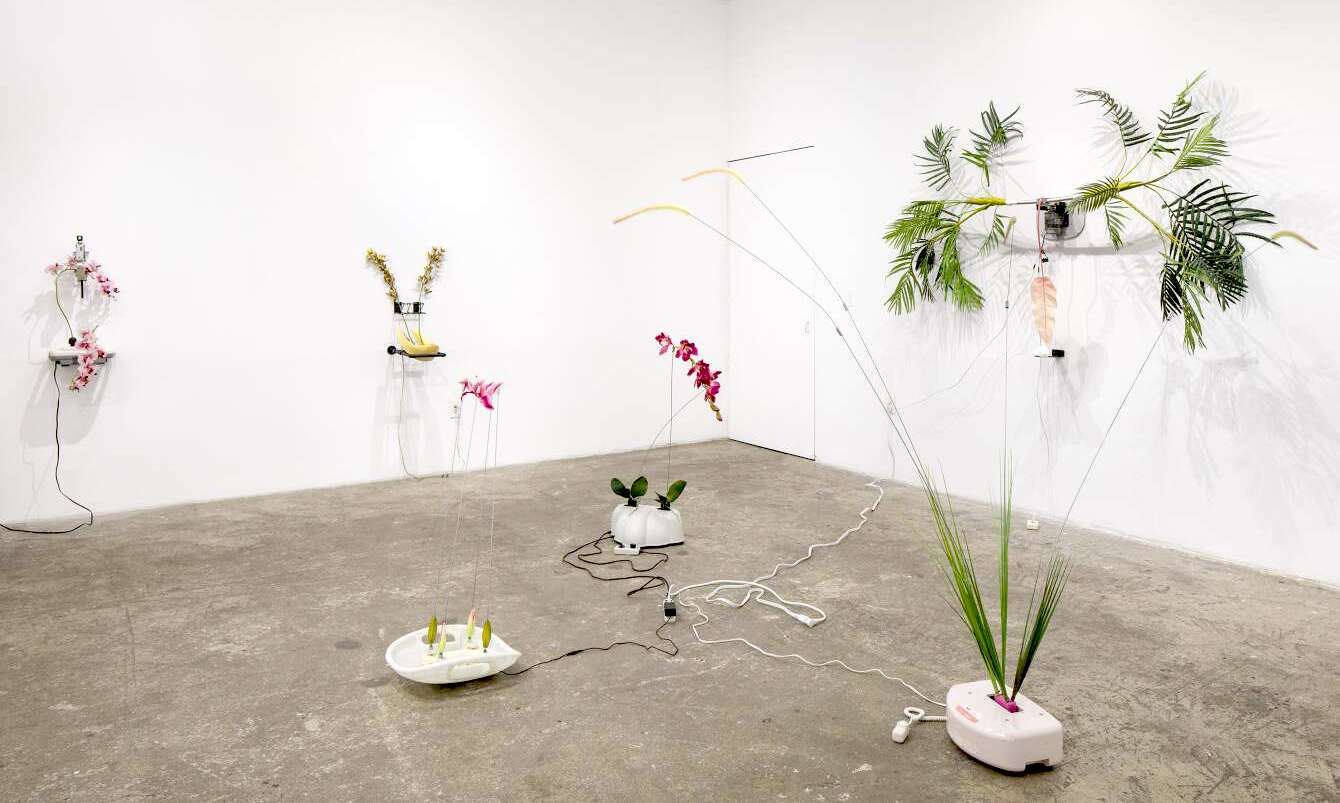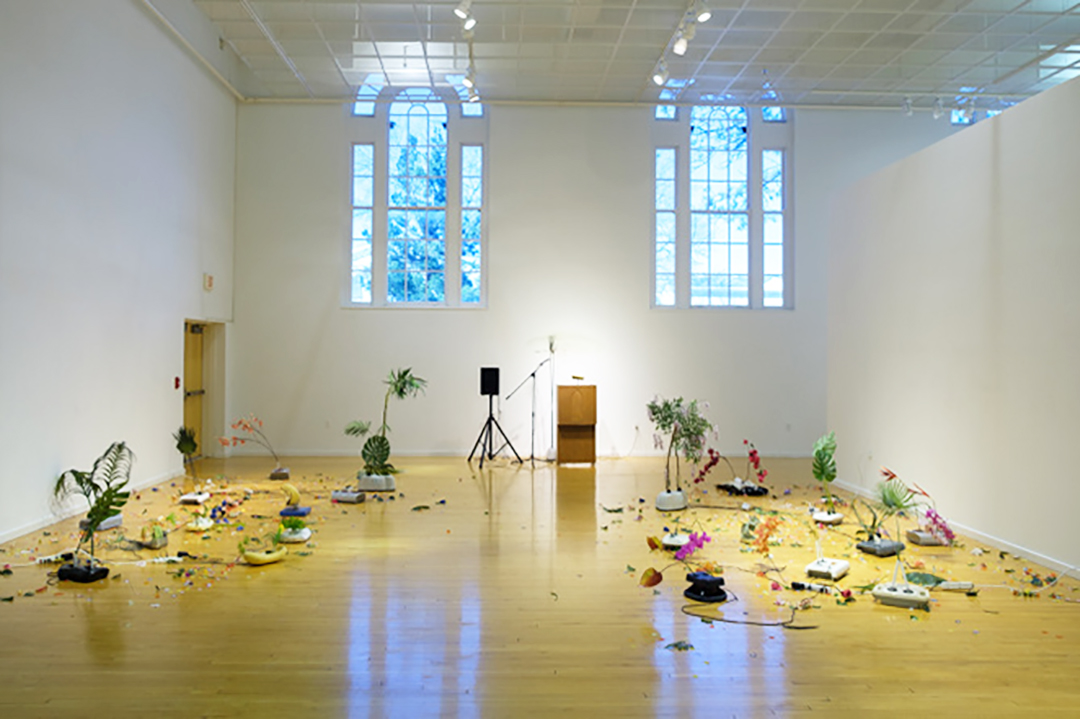Backdrop: Rachel Youn, installation view of Greener than grass at Truman State University Art Gallery, 2022. Photo: courtesy of the artist and Karl Ramberg
Video: No Pain No Gain, 2022. Courtesy of Sargent’s Daughters
Video: No Pain No Gain, 2022. Courtesy of Sargent’s Daughters
Frenetic energy is abound in the sculptural work by Rachel Youn. Vibrant faux plants gyrate with the aid of their fabricated appendages, animating the inanimate while subverting functionality to craft a queer ecology.
Throughout Youn’s sculptural and installation work, artificial plants are inserted into old shiatsu massagers. Youn builds an environment of cast-off consumer goods, giving them a new purpose outside of conventional assignment. In doing so, these objects are liberated from the static determination, quivering with the newfound potential.
In 10,000 hours, two faux birds of paradise rotate in circles within the confines of a metal music stand powered by a bygone shiatsu massager. The unexpected arrangement of these objects and their restless movements subvert expectations around their function. Here, the objects are anthropomorphized by both their wavering stems and the aural clicks, brushes, and buzzing of the motor. This kinetic sculpture, born from the cast-offs of yesterday’s capitalist darlings, is tenacious. Despite the labored and awkward sways of its stem, it persists. The endurance of this sculpture is underscored by its title, 10,000 hours, which is commonly understood as the amount of time it takes to achieve mastery of a complex skill or vocation.

Rachel Youn, 10,000 hours, 2022, shiatsu massager, artificial plants, wire stand, 39 x 21.5 x 16 inches.
However, the sculpture’s tireless movements seem to be in service of building an energetic community, like the vast underground root network of trees in a grove. Exposed power cords trace a constellation of circuits transferring electric pulses from sculpture to sculpture. Youn’s decision to highlight the interconnectivity between the works in the gallery underscores a sense of comradery among the pieces.
![]()
Rachel Youn, installation view of No Pain No Gain, 2022. Photo: courtesy of the artist and Sargent’s Daughters
Long stalks of a variety of fake flora, affixed to shiatsu massagers, dance among each other. Small fake flowers tremble with each cycle of the sculpture’s varying vibrations, asynchronistic yet inextricably linked. Each piece is made up of cast-off consumer items that wiggle with the gentle mechanical cadence of the bygone massager.
That all of the pieces are powered by the same device—a massager—evokes a sense of intimacy. The massager is meant to touch skin, kneading tight muscles until they release tension. Here, devoid of flesh, the machine uses its energy to lift and sway the found materials in an exuberant dance, alluding to the history of this particular era of massagers as an object used to derive covert sexual pleasure before the ubiquity of sex toys. This material subversion is a focal point and source of power. The erotic relationship between these objects is no longer hidden but celebrated in this environment.
![]()
Rachel Youn, installation view of Greener than grass at Truman State University Art Gallery, 2022. Photo: courtesy of the artist and Karl Ramberg
Youn’s installation, Greener than grass, builds upon the themes of a celebration of queer intimacy. The installation, comprised of over twenty plant-massager sculptures arranged in two sections, borrows the religious environment and turns it into a dance party. Each flower-massager quivers in two rows, facing a lectern with a microphone and amplifier. One tall frayed palm thwacks against the wall to the hum of the machines, resembling an impassioned pastor. The visual arrangement echoes a church service while the title, Greener than grass, conjures a sense of queer joy, as it is a line from Sappho's fragment 31.

Rachel Youn, installation view of No Pain No Gain, 2022. Photo: courtesy of the artist and Sargent’s Daughters
Long stalks of a variety of fake flora, affixed to shiatsu massagers, dance among each other. Small fake flowers tremble with each cycle of the sculpture’s varying vibrations, asynchronistic yet inextricably linked. Each piece is made up of cast-off consumer items that wiggle with the gentle mechanical cadence of the bygone massager.
That all of the pieces are powered by the same device—a massager—evokes a sense of intimacy. The massager is meant to touch skin, kneading tight muscles until they release tension. Here, devoid of flesh, the machine uses its energy to lift and sway the found materials in an exuberant dance, alluding to the history of this particular era of massagers as an object used to derive covert sexual pleasure before the ubiquity of sex toys. This material subversion is a focal point and source of power. The erotic relationship between these objects is no longer hidden but celebrated in this environment.

Rachel Youn, installation view of Greener than grass at Truman State University Art Gallery, 2022. Photo: courtesy of the artist and Karl Ramberg
Youn’s installation, Greener than grass, builds upon the themes of a celebration of queer intimacy. The installation, comprised of over twenty plant-massager sculptures arranged in two sections, borrows the religious environment and turns it into a dance party. Each flower-massager quivers in two rows, facing a lectern with a microphone and amplifier. One tall frayed palm thwacks against the wall to the hum of the machines, resembling an impassioned pastor. The visual arrangement echoes a church service while the title, Greener than grass, conjures a sense of queer joy, as it is a line from Sappho's fragment 31.

Rachel Youn, detail of Greener than grass at Truman State University Art Gallery, 2022. Photo: courtesy of the artist and Karl Ramberg
One of Sappho's most famous fragments, thought to be an account of experiencing love between women, describes an experience of love where her eyes, ears, tongue, and skin cease to function due to the intensity of attraction. Similarly, Youn’s plant-massagers function in a manner outside of their “intended” design, finding new purpose and belonging.
“A cold sweat covers me,
Wrapped in a chorus of vibration and thumping the floral participants exude joy and pain, connected by a web of electricity. Bearing the same determination as the sculptures throughout Youn’s work, these pieces work together to become unmoored from the confines of what is expected to forge a queer ecology.
1 Sappho, The Complete Poems of Sappho. Translated by Willis Barnstone, Internet Archive, Boston : Shambhala : Distributed in the United States by Random House, 1 Jan. 1970
Ava Morton (she/her) is an artist, writer, and educator based in the San Francisco Bay Area.
Ava’s writing and artistic practices are entwined and often focus on archives, linguistics, sound, and the boundaries of the body. Her artistic practice is interdisciplinary, stemming from archival research and often manifests as sculpture, installation, and video. In her most recent sound and installation-based work, she teases out the friction between collective and personal memory; she is currently fashioning sound collages spliced together from found audio, her recordings taken in transit, and recordings from family archives. She has exhibited in various art spaces including, Minnesota Street Project, Embark Gallery, Root Division, Pitzer College Art Gallery, Canyon Cinema Salon, PLAySPACE Gallery, and Hubble Street Gallery. Her writing has been published in Sightlines and 48hills.
Ava is a graduate of UC Santa Barbara with a BFA in Studio Art and Biological Anthropology and of California College of the Arts with a dual MFA/MA in Fine Arts and Visual and Critical Studies.
“A cold sweat covers me,
Trembling seizes my body,
And I am greener than grass.
Lacking but little of death do I seem.”1
Wrapped in a chorus of vibration and thumping the floral participants exude joy and pain, connected by a web of electricity. Bearing the same determination as the sculptures throughout Youn’s work, these pieces work together to become unmoored from the confines of what is expected to forge a queer ecology.
1 Sappho, The Complete Poems of Sappho. Translated by Willis Barnstone, Internet Archive, Boston : Shambhala : Distributed in the United States by Random House, 1 Jan. 1970
Ava Morton (she/her) is an artist, writer, and educator based in the San Francisco Bay Area.
Ava’s writing and artistic practices are entwined and often focus on archives, linguistics, sound, and the boundaries of the body. Her artistic practice is interdisciplinary, stemming from archival research and often manifests as sculpture, installation, and video. In her most recent sound and installation-based work, she teases out the friction between collective and personal memory; she is currently fashioning sound collages spliced together from found audio, her recordings taken in transit, and recordings from family archives. She has exhibited in various art spaces including, Minnesota Street Project, Embark Gallery, Root Division, Pitzer College Art Gallery, Canyon Cinema Salon, PLAySPACE Gallery, and Hubble Street Gallery. Her writing has been published in Sightlines and 48hills.
Ava is a graduate of UC Santa Barbara with a BFA in Studio Art and Biological Anthropology and of California College of the Arts with a dual MFA/MA in Fine Arts and Visual and Critical Studies.